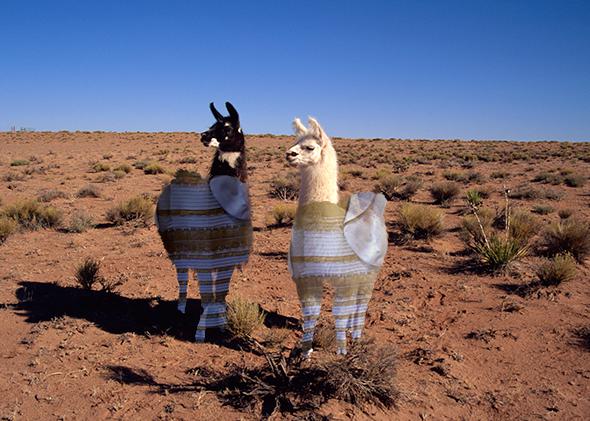So two llamas and an ugly dress walk into the Internet. The Internet says “Hey, cool, two llamas and an ugly dress!” (The llamas and the dress say nothing, lacking the capacity for speech.) Then, the Internet gets bored with the llamas and the dress, and wonders why it found them cool in the first place. Eventually, the Internet blames the media.
You’ve probably heard that one before. Whenever a meme catches the attention of the mainstream media, the story always ends with lots of people interpreting the media’s coverage of that meme as somehow indicative of declining journalistic standards and an impending idiocracy. Thursday, in which two runaway llamas and a color-shifting dress captivated online newsrooms worldwide, was no exception. Today, my Facebook and Twitter feeds are filled with people bemoaning coverage of “The Dress” as an unadulterated media fail.
These people are wrong. The media’s seemingly wall-to-wall reporting on the dress and the llamas—“BREAKING: Two llamas were on the run today in Arizona,” as the Washington Post put it—is a sign of journalistic strength, not infirmity. It represents what’s right about online media.
Consider: For decades, back when print and broadcast media monopolized news coverage, “newsworthiness” was determined in top-down processes, by editors and reporters who were only minimally accountable to the communities they served. Readers could write letters to editors, and could offer story tips, but that was the extent of their involvement in the news process. Journalists produced the news, readers consumed it, and if the reader didn’t like the news being produced, well, tough luck, because the reader needed the paper more than the paper needed any individual reader.
The disaggregation of news in the Internet age has inverted this relationship, and made news outlets hypersensitive to the interests of their readers. This is a positive development. It’s good that the media covers stories that its constituents are interested in and want to read about. It’s good when news outlets are connected to the communities they serve. If you’re the hometown paper of the Internet—something sites like BuzzFeed, Huffington Post, and, yes, Slate are all competing to be—then you had better keep tabs on the interests and priorities of the Internet. If you don’t, then you’ll go out of business, because, surprise, in a world of unlimited news choices, you need the reader more than the reader needs you.
When I worked at the Columbia Journalism Review, we talked a lot about the “hamster wheel”—the fear that the digital evolution of news would lead to journalists spending their days producing quick, worthless content at the expense of more thoughtful material. And, sure, it’s a bad thing when news sites pander to virality and completely sacrifice substance for fluff, but relatively few major online outlets actually work that way. BuzzFeed, Slate, the Atlantic, Huffington Post, Gawker, other prominent sites: They’ve all found ways to balance frivolity and substance, to cover the dress and the llamas while also covering hard news. The existence of one does not negate the existence of the other. To the contrary, the traffic from the fluffy stories helps underwrite and sustain the serious ones.
Besides, I’m loath to say that the llamas and the dress were fluffy. Newspapers have always had lifestyle and culture sections that specialized in so-called soft news. Covering Internet memes is just a variation on culture coverage, except it’s not tethered to Hollywood or the doings of rich people. Most of the time, coverage of memes is a positive development insofar as it represents a form of bottom-up culture reporting that’s organically generated, as opposed to top-down coverage of things the culture industries want to sell you. (Some memes are manufactured, of course.)
On Digiday this morning, Brian Morrissey used the tale of the dress as a means of making an interesting point about “viral sameness” and online media: the way that so many online news sites seem to offer the same takes on the same stories, often on websites that resemble each other. This is a real problem, but it’s hardly a new one. Newspapers, for instance, have always adopted relatively similar layouts, as a function of a common design grammar and the limitations of the print format. And the stories in those newspapers can feel similar, too, and not just because many newspapers reprint the same wire-service dispatches. Put 40 campaign reporters on the same bus for a year and then compare and contrast their stories at the end; you’ll find more similarities than differences. “Viral sameness” isn’t the problem: plain old sameness is the problem, and it’s been a problem as long as mass media have existed.
Attempting to play the same viral game as sites like BuzzFeed, writes Morrissey, is “a great way for legacy publications to lose all semblance of differentiation.” Perhaps. But there are fewer structural barriers to news differentiation these days than ever before. All the stories about the llamas and the dress may have looked relatively similar, but there’s no inherent reason why they had to. The smartest, most flexible news outlets will always find ways to take these sorts of stories and make them their own.
So two news outlets walk into the Internet to find that the Internet has become entranced by streaming footage of a llama chase in Arizona. One news outlet runs away screaming “Irrelevant! Irrelevant!” The other news outlet notices the Internet’s interest and runs a story about the llama chase, which appears alongside dozens of other stories on various topics. The latter outlet might end up being criticized by people who think it shouldn’t have wasted its time on something so dumb. But the joke’s on the first one. Because it’s hard to thrive as an online news outlet if you think you’re too good for the Internet.
Read more of Slate’s very comprehensive coverage of The Dress. No shame.
